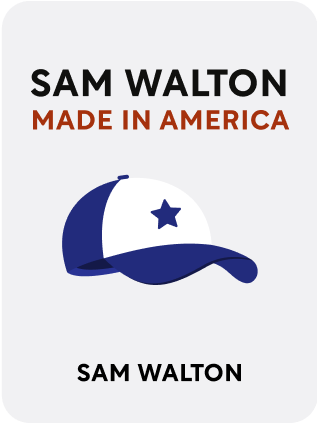

This article is an excerpt from the Shortform book guide to "Sam Walton: Made in America" by Sam Walton. Shortform has the world's best summaries and analyses of books you should be reading.
Like this article? Sign up for a free trial here .
What is Wal-Mart’s business strategy? How does Wal-Mart maintain its low prices and high volume?
In his autobiography Sam Walton: Made in America, Walton details his business strategy. This strategy enabled him to grow Wal-Mart from a single five and dime store to a nationwide superstore.
Here is Sam Walton’s Wal-Mart business strategy.
How Wal-Mart Operates
In Made in America, Sam Walton shares the key strategies that made Wal-Mart successful in retail. Here is Wal-Mart’s business strategy:
Retail Locations
Wal-Mart was judicious about where to open up stores.
- They started by setting up stores in small towns. Their discount formula worked even in towns under 5,000 people, while big competitors like Kmart were only going into large cities above 50,000. As a result, for a long time Wal-Mart faced little national-quality competition in its small towns.
- Even when big stores tried discounting, they didn’t really commit to it as a strategy. The incumbents were too accustomed to their 45% markup, and it was hard to let that go. Wal-Mart’s low prices disrupted them.
- As Wal-Mart expanded, they established stores with a radius of a day’s drive from a distribution center. They then filled in that territory, town by town, state by state until they saturated the area.
- They never planned to go into cities—they preferred to build stores in a ring around a city, then “wait for the growth to come to us.”
- In Springfield, MO, Wal-Mart had 40 stores within 100 miles. When Kmart finally came in with 3 stores, they had a tough time competing.
- They also preferred to build out ahead of a city’s expansion, then let the population build out to them.
Wal-Mart’s customer obsession and popularity in small towns caused helpful word of mouth. Rural towns would share the gospel of Wal-Mart with one another, and other towns would welcome Wal-Mart’s arrival. Furthermore, people who traveled South for the winter and saw Wal-Mart would clamor for stores up north. As a result, Wal-Mart already had demand in an area before they ever established a store there.
Low Prices, High Volume
Sam Walton believed that lower prices brought in more customers, period. Even though a lower markup meant lowered profits, they could more than make up for it with higher volume.
- In the book, Walton repeatedly mentions bins of “ladies’ panties, three for a dollar.”
- Some popular items like makeup and antifreeze are sold at cost, drawing in customers who then buy marked-up (but still cheap) items.
Wal-Mart stores were designed to be functional and omitted frills. Walton admits the stores were “truly ugly,” but they had prices 20% lower than the competition. This proved that people were ultimately looking for the best bargain.
At one point, a manager got a deal on an item with a list price of $1.98; he was able to buy it for 50 cents. The manager proposed selling it for $1.25. Sam objected: “No. We paid 50 cents for it. Mark it up 30%, and that’s it. If we get a great deal, pass it on to the customer.”
Merchandising and Promotion
Walton considered merchandising critical to retail—both stocking unique goods, as well as promoting them.
- In his first stores, Sam obsessed about finding unique goods that he could bring into his store and sell at a discount—like thong sandals and mattress toppers. When they couldn’t procure real Hula Hoops, he partnered with a rival store to make their own.
- Wal-Mart holds VPI (Volume Producing Item) contests between senior buyers to pick specific items that will sell the best (such as a minnow bucket or a brand of apple juice). This teaches store managers that some products can explode in sales, if the messaging and presentation are correct.
Promoting the merchandise was just as important as selection. Walton knew the power of calling attention to merchandise and dramatizing it.
- A store manager once ran ambitious promotions, buying 3,500 giant boxes of detergent and running a promotion at $1.99 rather than $3.97. While headquarters were skeptical about the volume, it made the local news and sold out within a week.
- A store pulled a similar stunt by having 200 riding lawnmowers, stacked in rows in front of the store.
Former Wal-Mart CEO David Glass noted that there are two types of retailers—merchandise-driven or operations-driven. Merchandise-driven retailers will win, because they can always work on improving operations. Operations-driven retailers tend to lose customer loyalty through weaker merchandising.
Experimenting/Innovation
Sam Walton was relentless in his drive to improve Wal-Mart. Never satisfied with where the company was, he boldly experimented with new ideas to improve stores, even creating entirely new retail store concepts.
- While running his Ben Franklin store in Newport, Arkansas, the franchise owners wanted to do things by the book. “It didn’t take me long to start experimenting—that’s just the way I am.” He approached suppliers who would do direct sales to his store; he promoted his shop with an ice cream machine; he priced his goods lower than standard.
- They made their Bentonville store the third self-service variety store in the country, at a time when this was a new concept. (Prior to this, the customer would ask the store clerk for what they wanted, and the clerk would pick out the goods behind a counter.)
- During the time of Wal-Mart’s expansion, each state was controlled by a major variety store (e.g. Oklahoma by TG&Y, Kansas by Alco). The competitors implicitly agreed not to cross state bounds. Sam wanted to break these borders.
Innovation was purposefully encouraged by store managers, who had freedom to try crazy things, and were trusted to do so since they had a personal stake in the store’s success.
- As previously mentioned, a store manager sold a massive volume of goods at steep discounts, including 2,500 detergent boxes and 200 lawnmowers.
- The same manager held a promotion for a TV sold at 22 cents, hidden somewhere in the store. A mass of people showed up and tore the store apart—overall a net positive, but they avoided this kind of chaos in the future.
Not everything worked. Plenty of efforts failed.
- Sam was excited by the European hyperstore concept, where a single store could combine a grocery, general market, bank, and arcade. This ultra-large-footprint store had disappointing results, but it gave rise to the more successful Wal-Mart Supercenter.
- Wal-Mart experimented with other retail verticals—Discount Drug for drug stores, and Save Mor for home improvement. Both failed.
Discount Retailing
Discount retailing was a new idea in 1962, and it was ridiculed by major retailers. That year, Kmart, Target, Woolco, and Wal-Mart were created.
The first three of these were subsidiaries of giant retailer chains—Kmart of Kresge, and Target of the Dayton Company. They had an advantage in speed—within 5 years, Kmart had 250 stores and $800 million in sales to Wal-Mart’s 19 stores and $9 million.
But Sam Walton considered Wal-Mart’s advantage to be scrappiness and innovation by necessity. They uniquely explored small-town America, believing other retailers underestimate the opportunity there. This required special adaptations to manage remote towns that larger stores were unprepared for.
- For example, to manage its far-flung stores, Wal-Mart had to handle inventory and communication at scale. They needed timely information on what was selling, what needed to be ordered, and how to control turnover. As a result, Wal-Mart became a relatively early adopter of computers.
Team Participation
Walton considered the Wal-Mart team the most important ingredient in the company’s success. He felt that Wal-Mart succeeded where dozens of other discount retailers failed, because they took care of their employees, and the employees in turn took care of their customers.
Walton instilled a culture of teamwork in a wide range of dimensions.
1) Wal-Mart calls all their employees “associates” to give a sense of partnership. Walton was inspired to do this when he passed a company sign in England that listed all its associates. Sam also called his employees partners.
2) Walton believed good ideas could come from anyone, and he eagerly sought opinions from employees on all levels for new ideas. The company formalized ways for the best ideas to percolate upwards:
- They flew in representatives from stores around the country to talk with management.
- They required regional managers to visit individual stores and leave with at least one good idea they saw.
- Wal-Mart’s famous store greeters came from a single Louisiana store that instituted it to combat theft.
- At the headquarters’ Saturday meetings, they dedicated time to showcasing great new ideas.
- The company held Volume Producing Item contests for department managers to choose an item to promote and compete in sales.
Look for people who have unorthodox ideas and keep them around.
3) Walton believed in liberally sharing private information and company financials with his associates, for a few reasons:
- He believed that having all the information was the only way people could do their job to the best of their ability.
- If you can’t trust your associates to know what’s going on, then you don’t actually consider them partners.
- Being trusted with information makes people feel more engaged and responsible for the team’s success.
All these benefits outweighed the downside risk of having company info leaked publicly.
4) Every year, every Sam’s Club and Wal-Mart store elects an associate to attend the annual shareholders’ meeting.
- The meeting is less about honoring shareholders than about recognizing the people responsible for delivering on investments.
- All associates are invited to Sam’s house for a lunch.
- The elected associates tend to be leaders in their stores, who are then tasked with reporting back to their store staff.
5) Through the decades, Wal-Mart has resisted worker unions by treating its associates better.
- Walton believed that unions are purposely divisive, putting management on one side and employees on another side, to justify their role in the middle. Their incentive is to create conflict to make their work meaningful.
Profit Sharing/Stock Ownership
Having employees share financially in the success of Wal-Mart made them committed to the company’s success. Walton employed this liberally:
- Early on before Wal-Mart went public, Sam Walton set up new stores as partnerships and allowed early managers to invest up to $1,000 in new stores (for a 2% stake in a $50k investment). This profit participation attracted hungry talent and made the managers naturally invested in store performance.
- For decades, Wal-Mart had a profit sharing program—equivalent to roughly a 6% bonus on wages each year, which could be taken out as cash or stock when the employee left the company. This led 80% of associates to have equity ownership in the company. (Shortform note: This has since been discontinued in favor of 401k matching.)
- A truck driver who worked for Wal-Mart for 20 years eventually earned $707,000 in profit sharing. He commented, “When folks ask me how I like working for Wal-Mart, I tell them I drove for another big company for 13 years and left with $700. Then I tell them about my profit sharing and ask them, ‘How do you think I feel about Wal-Mart?”
These incentives could also be constructed on a smaller level. For example, one store had a theft problem. They instituted a bonus: if they could reduce shrinkage below a target goal, every associate could get a bonus of as much as $200.

———End of Preview———
Like what you just read? Read the rest of the world's best book summary and analysis of Sam Walton's "Sam Walton: Made in America" at Shortform .
Here's what you'll find in our full Sam Walton: Made in America summary :
- The story of Sam Walton and how he started Wal-Mart
- How Wal-Mart grew from a single five and dime store to one of the world's largest companies
- Sam Walton's retail strategies and management advice






